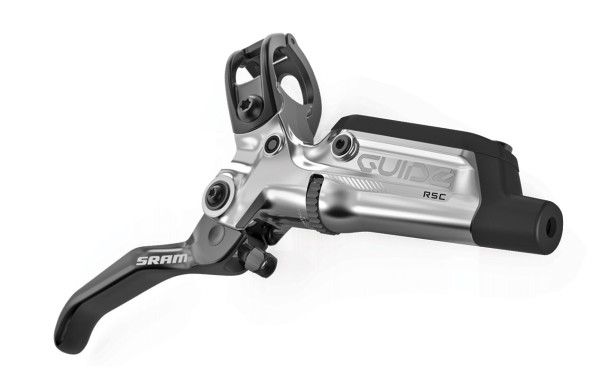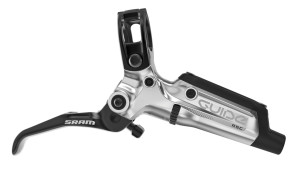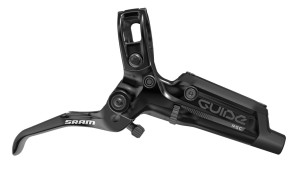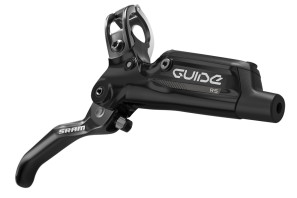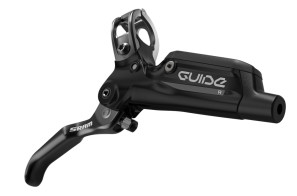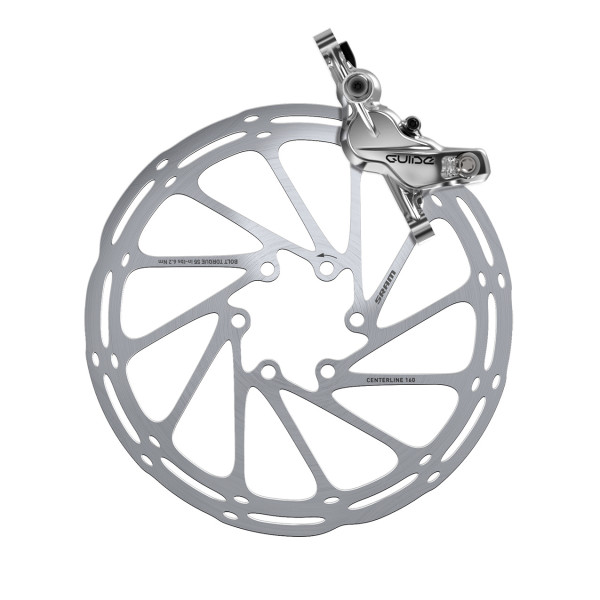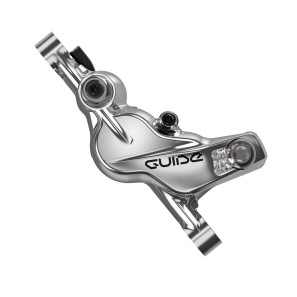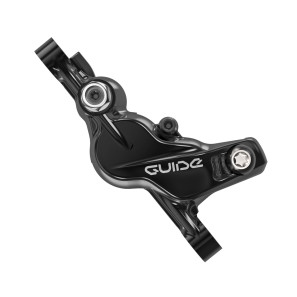SRAM has new mountain bike brakes, and they’re not from Avid. After years of hit or miss performance from the Elixirs, SRAM is introducing an entirely new braking platform called the Guide. The move from Avid to SRAM is labeled as a chance for a clean slate and change in design philosophy. The result is an all new DOT Fluid hydraulic disc brake that they claim is packed with the best technology and solutions to a powerful, durable, light weight brake. Called Swinglink and TPC Plus™ (not to be confused with Manitou’s TPC +), the new technologies combined with a piggyback reservoir instead of the Taperbore look like a good start for worry free braking.
Squeeze the lever for more on the new brakes…
Broken down into the R, the RS, and the RSC for models, like other SRAM/Avid brakes in the past the higher end brakes carry more letters and more features. In this case R stands for Reach Adjust, S is for Swinglink, and C is for Contact Point Adjust. While only offered on two brakes, Swinglink is the real talking point as it is a new cam system that provides more positive pad engagement with less deadband (which sounds similar to Shimano’s Servowave). The system uses a special cam shape so that the pads move quickly towards the rotor, but once they get there, it’s more than just on/off. Swinglink is said to modulate the power providing the perfect blend of power and precision. We haven’t tried the brakes yet, so we can’t vouch for Swinglink’s effectiveness.
After Swinglink, the next new technology stuffed into the lever is TPC Plus. SRAM’s new TPC (Timing Port Closure) system replaces the Taperbore system and uses a series of durable seals with an “ultra smooth” cylinder bore finish for performance. TPC Plus controls the opening from the master cylinder bore, and the new Piggyback Reservoir which allows for ambidextrous brake placement, and will probably mean easier bleeds. The new Pure bladder should also help as well, with a new shape that is designed to help regulate and reduce air bubbles. It’s designed to help eliminate air from the lever, and push only fluid through the lines.
Guide RSC brakes have the addition of a Contact point adjustment which is housed in the body of the brake lever. By spinning the dial users can adjust the brake throw to be short or long, depending on preference. Tool free Reach adjust is available on all three Guide models via the small adjuster knob on the brake lever pivot.
GUIDE RSC SPECS
- Weight: 375 Grams
- Contact Point Adjust
- Tool-free Reach Adjust
- MatchMaker X Compatible
- Lever Pivot Bearings
- Guide caliper
- Colors: Polished Silver Ano or Black Ano
- MSRP: $199 / € 177
TECHNOLOGIES
- SwingLink
- Pure Bladder
- TPC Plus
GUIDE RS SPECS
- Weight: 380 Grams
- Tool-free Reach Adjust
- MatchMaker X Compatible
- Guide caliper
- Colors: Black
- MSRP: $149 / € 132
TECHNOLOGIES
- SwingLink
- Pure Bladder
- TPC Plus
GUIDE R SPECS
- Weight: 375 Grams
- Tool-free Reach Adjust
- MatchMaker X Compatible
- Guide caliper
- Colors: Black
- MSRP: $129 / € 115
TECHNOLOGIES
- DirectLink™
- Pure Bladder™
- TPC Plus™
All of the new brakes are equipped with the new Guide caliper which is a dual diameter quad piston design. The 14 and 16mm piston design is said to provide loads more useable power at only a 4g weight penalty over an XC caliper. The caliper will be paired with the new Centerline rotor which promises quiet performance by keeping the center of friction consistent throughout rotation. This should mean less vibration, and maybe (?) the elimination of turkey gobble, or chatter.
Rotors will be offered in 140, 160, 180, and 200mm sizes in one piece, 6 bolt only. SRAM Guide brakes will be available in June, 2014.
